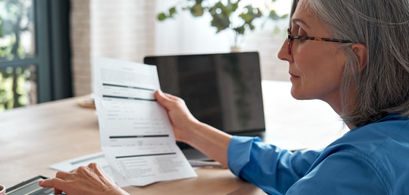Are you looking for ways to minimise the tax burden on your pension? Understanding the intricacies of pension taxation is essential for optimising your retirement income.
In this article, we delve into the factors that determine the tax you pay on your pension and explore strategies to help you avoid paying excessive taxes.
From pension allowances to smart withdrawal strategies, we'll provide valuable insights to help you navigate the complexities of pension taxation and potentially reduce your tax liability.
Key Takeaways
You pay tax on your pension when the total amount you receive in one tax year exceeds the minimum threshold for income tax.
One of the best ways to reduce your pension tax bill is to make use of pension allowances such as the Lifetime Allowance and Annual Allowance.
You can lower your tax bill by taking small amounts from your pension gradually over time and remaining in a low tax bracket.
How Much Will I Be Taxed on My Pension?
The amount of tax you pay on your pension depends on how much you earn and other factors such as age, type of contribution, and benefits. Let's explore each category in detail;
Tax on state pension
The income you receive from your State Pension is subject to taxation, however, it is typically disbursed without any tax deductions. This is because while you're not directly taxed on your State Pension, it does consume a portion of your tax-free personal allowance.
For the tax year 2023/24, the standard tax-free personal allowance stands at £12,570 and the state pension is £10,620. If you're receiving the full State Pension, your remaining personal allowance for other taxable incomes, like employment or private pensions, would be £1,969.80 (£12,570 - £10,620).
Note that if you've postponed your State Pension claim or paused it for some time, you won't be taxed on the State Pension during the period you're not receiving it.
Tax on personal pension
Private pension contributions in the UK are tax-exempt, up to certain limits. This applies to most private pension schemes, including workplace, personal, and stakeholder pensions.
If you have a workplace pension (defined benefit or defined contribution), you will receive a lifelong income, which is taxable. The initial quarter (25%) of the withdrawal is tax-free while the remaining amount is taxable as earnings.
Tax on pension lump sum
Each time you decide to withdraw from your pension, 25% of that amount is tax-exempt. However, the remaining 75% is considered taxable income and is added to your other sources of income. Your total income determines your tax bracket – which is used to calculate the amount of tax you need to pay.
The standard tax-free allowance for 2023/24, is £12,570 and you only pay tax when your total annual income is more than this personal allowance.
Here's a summary of the different income tax brackets;
Taxable Income | Income Tax Rate | |
|---|---|---|
Personal Allowance | From £0 - £12,570 | 0% |
Basic Rate | £12,571 - £50,270 | 20% |
Higher Rate | £50,271 - £125,140 | 40% |
Additional Rate | More than £125,140 | 45% |
Other tax rules around continuing to save
If you have a drawdown pension, the tax rules will depend on the type of drawdown while your perks depend on your pension provider.
If you have a flexi-access drawdown, you'll be able to buy an annuity and make withdrawals and contributions. If exceed your money purchase allowance, you'd be required to pay tax on your contributions.
If you have a capped drawdown, you can keep paying in and your money will remain invested. You also have the option to make withdrawals not exceeding the cap set by your pension provider.
Tax when taking money out
Depending on how you withdraw your pension and what type of pension you have, here’s all you need to know about how you’re taxed when taking money out of your pension.
What Portion is Tax-free? | What Portion is Taxed? | |
|---|---|---|
If you make no withdrawals | All your pension is tax-free while you make no withdrawals. | Your pension isn’t taxed since no withdrawals are made. |
You choose to get an annuity | 25% of your pension before you purchase the annuity. | The income you make from the annuity. |
You opt for a flexible retirement income (pension drawdown) | 25% of your pension before moving to a pension drawdown. | Any income you take out from the pension pot. |
If you withdraw your pension pot in multiple lump sums | 25% of each withdrawal you make. | 75% of each withdrawal you make |
Withdrawing all your pension at once | 25% of the total pension amount. | 75% of the total pension amount. |
How is pension tax calculated?
Your pension tax is calculated based on your total income and personal allowance. Your total income is the full amount you receive from your State Pension, private pension, lump sum withdrawal, and any other sources.
The total taxable amount of your pension contributions will be added to your other sources of income, which determines the tax rate you're eligible for.
For example, if you’re earning £30,000 with a personal allowance of £12,570, your taxable income becomes £17,430.
If your pension contributions amount to another £10,000, then you need to factor out the 25% tax-exempt portion of it, and the total taxable amount would be down to £7,500. The total taxable income in this case would be £24,930. This falls into the basic rate band of 20%.
What is an emergency tax?
Emergency tax is a situation where you are taxed at a higher rate than the one you're eligible for. This usually happens when your employer doesn’t have enough information on your income and tax status to calculate the correct amount of tax that needs to be deducted from your salary or pension payments.
As a result, they might apply an emergency tax code that assumes you are a basic-rate taxpayer and deducts the tax accordingly.
Emergency tax on your pension lump sums
In certain situations, you might find yourself being taxed at an emergency rate when you decide to pull out a lump sum from your pension. This happens when the amount of your lump sum exceeds the total taxable income from all other sources including benefits and salaries.
There are a few ways to avoid emergency taxation on pension lump sums:
Make sure that your employer or pension provider has the correct information regarding all of your other income sources so they can calculate your tax liability accurately.
You can also provide a valid P45 form that documents your earnings from the previous year to provide more accurate information about your total taxable income.
You can also contact HMRC directly and ask them to provide your pension provider with an up-to-date tax code that takes into account all of your other sources of income. This will ensure that any future lump sum withdrawals are taxed correctly at the marginal rate instead of being over-taxed at the emergency rate.
What’s Tax-Free?
Now you know how to calculate the tax on your pension and determine what percentage is tax-free cash. Here we take a closer look at the numbers.
Lump sums from a pension
If your total yearly income doesn't exceed your Personal Allowance, you're generally off the hook for paying taxes. The usual Personal Allowance is set at £12,570 and this is the chunk of your income that's not subject to tax.
Your Personal Allowance could be more if you're eligible for a Marriage Allowance or a Blind Person's Allowance. However, it decreases if your earnings are over £100,000.
Earlier on, we established that you can withdraw up to 25% from any pension as a lump sum without being taxed. But, this is capped at 25% of your lifetime allowance of £1,073,100.
Taking out a pension
Pensions valued at £10,000 or less
If you have a pension of not more than £10,000, you can cash it all at once. This is referred to as a 'small pot' lump sum.
Generally, you can claim:
up to three lump sums from various personal pensions
unlimited lump sums from your workplace pensions
Pensions valued at £30,000 or less
If the total sum of all your private pensions is £30,000 or less, you typically have the option to withdraw the full amount from your defined benefit or defined contribution pensions as a lump sum.
But, if this lump sum comes from more than one pension, you need to ensure that all payments are received within 12 months from the date of the first payment.
Cash held in a defined contribution workplace pension
In this case, you can take all of your pension as cash or as small lump sums. You still get 25% tax-free up to 25% of the standard lifetime allowance of £1,073,100.
How Can I Pay Less Tax on My Pension?
So far, we've discussed the different types of tax applicable to pensions and how it is calculated. Now let's look at how you can pay less tax on your pension.
1. Only withdraw the amount you need each tax year
The tax year runs from the 6th of April to the following 5th of April and you can keep this in mind while planning how much to withdraw from your pension.
The best approach is to take just enough to live comfortably and cover your essential expenses while leaving the rest of your pot invested. That way, you can benefit from tax-free growth for longer and enjoy a larger pension pot later on.
Taking too much from your pension in a tax year can plunge you into a higher income bracket, resulting in higher taxation on your withdrawal.
2. Take advantage of a drawdown scheme
A drawdown pension is a retirement solution where you keep your money invested and draw an income from investments. Drawdown pensions provide flexibility, allowing you to choose how much you want to withdraw each month or year. This means that if you only need a certain amount in a particular tax year, you can limit your withdrawals accordingly and pay less tax.
3. Take small pension pots worth less than £10,000
If your pension pot is worth less than £10,000, you can cash up to three small lump sums. This is known as a ‘small pot’ lump sum and allows you to avoid the high tax liability associated with larger pots.
Additionally, the withdrawals don’t count towards your lifetime allowance of £1,073,100. This means that you can enjoy your retirement fund without having to worry about paying an excessive amount of tax.
4. Never push yourself into a higher tax bracket
Your tax bracket is determined by the amount of income you earn during the tax year. If you find that your pension pot puts you in a higher tax bracket, it's important to review how much money you're taking out and make sure it does not exceed the threshold for any given tax band.
For instance, the basic rate bracket applies to people with taxable income ranging from £12,571 to £50,270 and requires them to pay 20% tax. If you exceed this amount, you will be pushed into the higher rate of 40%.
5. Use your ISA savings to initially provide a retirement income
Using the tax-free allowances from an Individual Savings Account (ISA), you can withdraw money each year without having it taxed.
Withdrawing money from your ISA is much more advantageous than drawing money out of your pension pot, as the withdrawals are not counted towards your lifetime allowance and won’t potentially push you into a higher tax rate.
This strategy is particularly useful if you are not yet ready to draw an income from your pension pot. Instead, you could use the money in your ISA to provide an income and wait for your pension pot to grow bigger before making any substantial withdrawals.
6. Access your pension income last
If you still have other sources of income such as rental, dividends, or savings, it is best to use these first before withdrawing from your pension pot. This will help you stay in the lower-rate tax brackets and ensure that you pay less overall tax on your retirement funds.
It is also important to factor in any changes in your circumstances when making plans about how much to withdraw from your pension.
For instance, if you are likely to receive income from other sources that will push you into a higher rate of tax, it may be better to hold off on taking any withdrawals until the following tax year.
How Do I Pay Tax on My Pension?
Depending on your circumstances, there are three ways of paying tax on your pension: through your pension provider, your employer, or a Self-Assessment tax return.
Through your pension provider
If you are withdrawing money from your pension provider, they may deduct the relevant amount of tax before paying out any remaining funds.
This means that the amount you receive will depend on how much taxable income has already been declared in that tax year. Of course, not all pension providers will deduct tax from your withdrawals, so it is important to check with them before taking out any money.
Through your employer
For those with workplace pensions, tax deductions may be taken from your pension payments before they are received. The total amount of tax deducted depends on the type of pension plan you have and how much taxable income you have earned in that tax year.
Employers will usually allow you to discuss your tax deductions with them and make any changes you require.
Self-Assessment tax return
The Self Assessment system is a process used by HM Revenue and Customs (HMRC) to collect Income Tax. Normally, tax is deducted automatically from wages, pensions, and similar income sources.
However, if your pension tax isn't automatically deducted or you receive the state pension, you're required to submit a Self-Assessment tax return.
You have the option to submit your tax return online or you can reach out to HMRC to ask for the SA100 form. Once you've completed your Self Assessment tax return, HMRC will calculate what you owe based on the information provided.


